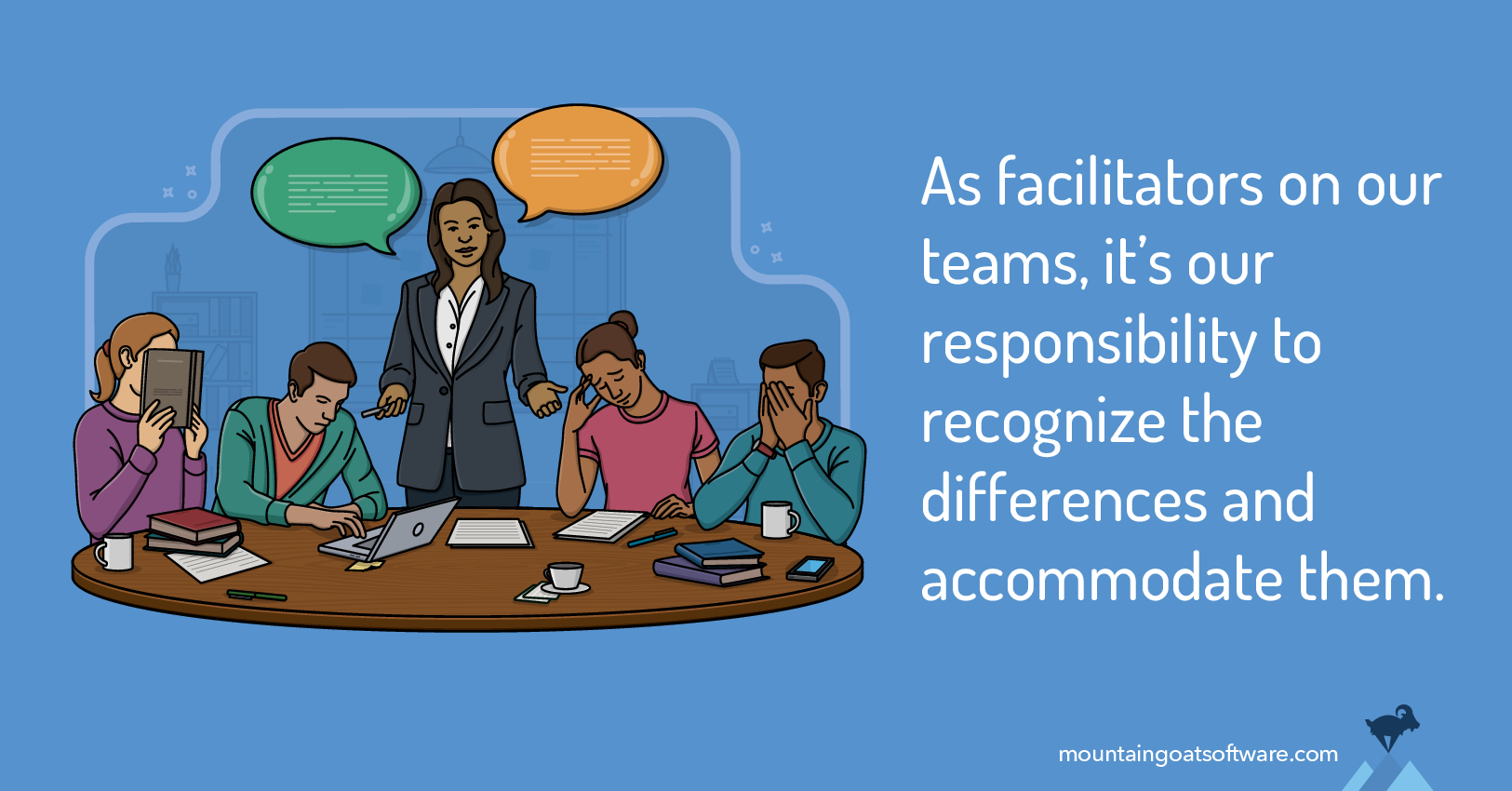Recently a question was submitted to us about how to deal with a team that’s a bit quiet in retrospectives. The team is showing up for their retrospectives, but since they’re all a bit introverted, they don’t always leave with actionable items. Retrospecting on the retrospectives doesn’t work either, due to the same issue. The person asking the question felt a bit hopeless that things would ever change on the team.
It’s not surprising that many developers tend to slant introverted. A thoughtful and methodical nature is very helpful in examining all the angles and approaching issues reasonably. But if you get them all in a room and try to have an open discussion about how things are going on the team, you’ll likely only hear crickets.
Let’s start solving this issue by inventorying the assets. Many qualities make introverts ideal developers on a scrum team. Take a look at a few that I found published elsewhere online:
- They are good listeners
- They excel at critical thinking
- Quality and accuracy are highly important to them
- They’re typically detail-oriented
- They will explore problems from many angles
Next, let’s dissect the issue a little. For starters, recognize that introversion isn’t binary: People are not completely introverted or extroverted but rather degrees of introversion and extroversion. You could have an introvert on your team that hates speaking up in retrospectives but loves demoing the product in a sprint review, for example. So don’t feel like you have to classify everyone into one of two categories; it’s neither accurate nor constructive.
If my team is having problems speaking up in my retrospectives, it’s time to examine how I’m facilitating and find alternative methods that fit better with the team personalities. If you begin a retrospective with an introverted team by asking them to talk about anything they liked or didn’t like about the sprint, the silence will be deafening. Right here, as always, it helps to tailor your approach to your team. So who is your team? Who are these introverts, anyway?
1. Introverts prefer not to have to speak up in front of a group of people.
Most people are afraid of public speaking: a National Institutes of Health survey found that 75% of people listed it as their number one fear. Some people fear speaking to a large group but those tending toward introversion will dread addressing even a team of ten or less. So trying to facilitate groups by using an open discussion method—opening the floor to anyone who wants to bring up an issue—simply proves that no one on your team wants to bring up an issue. This isn’t fresh data, is it?
Find ways of letting them participate without speaking. Electronic tools are great for this purpose but even sticky notes work just as well. The key is to provide them a way of interacting that doesn’t require them to call attention to themselves. Be careful that if you use something like sticky notes, you don’t undo your work in your retrospective by reading the sticky note aloud and asking whose idea it is in front of the group. Instead, collect your ideas but then call an anonymous vote to try to surface the most important points for discussion.
2. Introverts will open up when they feel safe to do so.
Psychological safety is a hugely important aspect of a successful retrospective for introverts and extroverts alike. If your team doesn’t feel safe to talk about their issues in a retrospective, you won’t get the data you need. Spend time on exercises and discussions that create a sense of safety on the team; this makes for some of the most productive retrospectives you can have early on with a team.
Start by taking the temperature of the team about their sense of psychological safety. As an opening exercise, find an anonymous way to have them vote on how safe they feel to speak their minds honestly in this retrospective on a scale from one to five. There are online tools for this but something as simple as pieces of paper in a hat will work too. Collect the answers and publicly track your average score each retrospective. Is safety increasing or decreasing with the group?
If you find that trust is low, focus on problem-solving in a retrospective. Have people fill out chits of paper to brainstorm. Why do we feel it’s low? How can we improve it? Additionally, spend time getting to know each other as human beings more. Devote an entire retrospective to learning about each other. You might do an exercise like Journey Lines by Lyssa Adkins or something more simple like having everyone list their Top 5 super powers as a team member. For remote teams, do a show and tell: Have everyone bring an item that is important to them and explain why it’s important. This could be a photo or an object. The idea is to learn more about each other, but to provide a non-controversial subject matter to reduce the fear of public speaking. Doing so goes a long way in building trust—because when there is trust, there is safety.
3. Introverts need time to process
Learning this can be the trickiest and will require more facilitation skill on your part. Retrospectives work best (and were invented to be) a time-bracketed group activity: the whole team is together and discusses things openly all at once. If my team acts very introverted, maybe it shouldn’t be timeboxed traditionally. Maybe I provide them with a few different ways to consider things over a longer period of time.
Nuts and bolts of this? Set up a way for your team to submit items for the retrospective discussion incrementally, throughout your sprint. Have an anonymous drop box (either physical or virtual) where they can deposit issues they’ve encountered during the sprint that they would like to discuss at the retrospective. This will remove the time pressure of having to think of every issue during the retrospective time box.
Give people a chance to circle back as well, to continue the discussion past the retrospective. Establish a virtual or physical location where items from the last retrospective are kept and tracked but which also allows people to suggest improvements on those items throughout the next sprint. Introverts often have their best ideas outside of meetings. So provide them ways to tap into that creativity as it happens: before, during, and after the retrospective.
A quiet team doesn’t have to be a bad thing. As facilitators on our teams, it’s our responsibility to recognize the differences and accommodate them. Scrum Masters are here to help our teams be the most successful possible versions of themselves. So inspect and adapt: provide the right framework to help them thrive when they retrospect and work to improve each sprint.
Last update: February 12th, 2025









